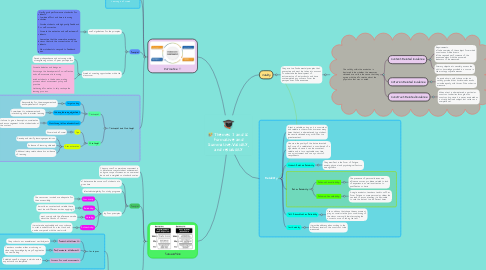
1. Validity
1.1. They are two fundamental principles that guarantee and must be taken into account to undertake the development of instruments as final products and have contemplated any concern from the perspective of the examinee.
1.1.1. The validity within the evaluation is declared to be whether the measures obtained are valid in the sense that they agree with the information about the population that was created.
1.1.1.1. Content-Related Evidence
1.1.1.1.1. Requirements: a) take samples of the subject from which conclusions will be drawn b) the required performance of the examinee aligns with the assumed behaviors to be measured.
1.1.1.1.2. Primary objective to sensibly assess the skill or knowledge provided in a course in the most appropriate manner
1.1.1.2. Criterion-Related Evidence
1.1.1.2.1. An evaluation is said to have criterion validity, provided that its obtained results coincide equally with those of the criterion measure.
1.1.1.3. Construct-Related Evidence
1.1.1.3.1. When a test is administered, a particular construct underlies throughout its construction, since it is never evaluated as a strictly defined subject, but rather as a complete set.
2. Reliability
2.1. A test is reliable, as long as it is consistent and reliable. In other words, however many times the test is administered to a student, the results obtained may not differ to a greater extent.
2.2. Likewise, the quality of the data extracted by force of a reliable test is considered of a high standard, since it can be consistent, reliable and, in turn, replicable over time, on any instrument and on any cohort of respondents.
2.3. Student-Related Reliability
2.3.1. They manifest in the form of fatigue, anxiety, physical and psychological factors, among others
2.4. Rater Reliability
2.4.1. Inter-rater reliability:
2.4.1.1. The presence of personal biases can influence scores, problems related to lack of experience, as well as attention to qualification criteria.
2.4.2. Intra-rater reliability:
2.4.2.1. A single evaluator, teachers tend to suffer from fatigue or some personal problem, this can lead to inconsistencies, it is advisable to rate the data at two different times.
2.5. Test Administration Reliability
2.5.1. The conditions that shape the environment play a crucial role the poor conditioning of the classroom, could be interrupting the correct curse of taking the test
2.6. Test Reliability
2.6.1. It must be addressed according to the different levels of the construct to be measured.
3. Formative
3.1. Provides feedback and seeks to improve student achievement of intended instructional outcomes.
3.1.1. occurs in teacher-student interaction
3.1.2. while delivering task-oriented information.
3.2. The teaching is receptive. Learning is informed
3.3. Principles
3.3.1. useful guidelines for the principles
3.3.1.1. •Clarify good performance standards for students. • Combine effort and time in learning activities. • Provide students with high-quality feedback for self-correction. • Promote the motivation and self-esteem of students. • Guarantee that the summative evaluation does not disturb the concentration of the students. • Allow students to respond to feedback given.
3.3.2. Aimed at creating opportunities within the classroom
3.3.2.1. Develop independence and autonomy while strengthening notions of peer participation.
3.3.2.2. Promote debates and dialogues. Encourage the development of co-reflection and self-assessment in learning. Include students in the decision-making process about assessment policy and practice Gathering information to help reshape the learning process.
3.4. Techniques and Strategies
3.4.1. Techniques
3.4.1.1. Target-setting
3.4.1.1.1. Responsibility for the management and accomplishment of targets
3.4.1.2. Sharing learning objectives
3.4.1.2.1. Commitment to achievement and interlocking skills to master learning
3.4.1.3. Structuring lesson introductions:
3.4.1.3.1. It allows to give a description, socialization and encouragement to the students about the content
3.4.2. Strategies
3.4.2.1. Tipe
3.4.2.1.1. Formal and Informal
3.4.2.2. Characteristics
3.4.2.2.1. Develop and clarify learning expectations.
3.4.2.2.2. Evidence of learning obtained
3.4.2.2.3. Additional interpretation based on evidence of learning.
4. Summative
4.1. The purpose of summative assessment is to determine overall student achievement and governs performance on a numerical basis and is weighted on standard scales.
4.2. Principles
4.2.1. a) determine the success of students at a given time
4.2.2. b) establish eligibility for study programs
4.2.3. by four principles:
4.2.3.1. Practicality:
4.2.3.1.1. The resources involved are adequate for their accessibility
4.2.3.2. Reliability:
4.2.3.2.1. It must be consistent and reliable, there must be no difference when applying it.
4.2.3.3. Validity:
4.2.3.3.1. must comply with the inferences made about the results of the test
4.2.3.4. Authenticity:
4.2.3.4.1. It must make applicability and concordance to what is understood as a test task and can be compared with the real world.
4.3. Techniques and Strategies
4.3.1. Techniques
4.3.1.1. Product-assessments:
4.3.1.1.1. The product can resemble real world objects
4.3.1.2. Performance-assessments
4.3.1.2.1. Teachers consider either monitoring or observing knowledge by way of application in a real setting.
4.3.1.3. Process-focused assessments
4.3.1.3.1. Establish specific stages in which certain aspects are contemplated.
4.3.2. Strategies
4.3.2.1. Rubric usage
4.3.2.2. Devising crystal-clear questions
4.3.2.3. Blind grading
4.3.2.4. Wider breadth assessment
4.3.2.5. Post-test applications
4.3.2.6. Real-world approaching
